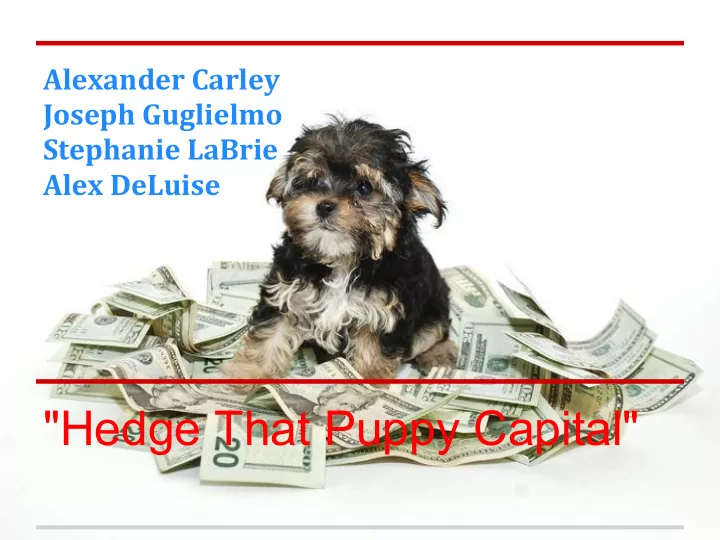

Alexander Carley Joseph Guglielmo Stephanie LaBrie Alex DeLuise "Hedge That Puppy Capital"
Hedge Fund Style ● Our strategy is based off of a Long/Short equity hedge fund model. Taking long and short positions in equities while seeking to reduce exposure to the systematic risk of the market. ● We are value driven. ● For securities undervalued (higher intrinsic value compared to market value) we take long positions in these companies. ● For securities overvalued compared to their intrinsic value, we take short positions in these securities. We will take short position in securities that are countercyclical to our long positions to hedge our portfolios risk. ● We also take and hold growth securities. Although, we do not hold these for an extended period of time. ● To additionally mitigate the risk of our portfolio, we implement Micro and Macro-hedges when appropriate
Principal Investment Strategy ● The principal investment strategy of our Hedge Fund is to beat the annual S&P 500 return through long equity value driven analysis in primarily large cap companies as well as market ETFs. ● Ultimately, our goal is to be profitable no matter which direction the market moves
Expected Returns Indicated by the historical data on the next page, we expect the Fund to outperform an unhedged fund on a risk-adjusted basis. Protecting downside risk and limiting negative returns through hedging keep the average fund performance well above that of an unhedged fund.
Relationship Between HF Size and Risk ● Hedge fund size is dictated by Assets Under Management (AUM). ● Larger hedge funds are riskier than smaller ones due to the added pressure of maintaining past performance. Managers have incentives to take on additional risk in order to generate a return greater than a minimum value. ● Hedge funds cannot generate capital like investment banks and when concerning news hits the market, investors in turn become concerned and pull their funds leading to lower AUM and an inability to properly manage the fund. ● Due to the difficulty in generating capital, large hedge funds must sometimes liquidate large positions, this causes a dramatic price decrease and as a result a loss for the funds' investors.
Market Risk (beta and adjusted-beta analysis) ● Market risk is that which is a result of movements in the market. ● Beta, VaR, and Vasicek beta are ways to measure market risk. ● Beta makes assertions regarding the correlation of the security or portfolio in question to the overall market. A beta of 1.0 means that the security is perfectly correlated with the market and its price will move with the market. ● Vasicek beta is an adjusted beta that is considered a better measure of systematic risk.
Tax Management Issues ● Hedge funds are structured as partnerships. Managers are considered partners. ● Treated as a corporation for tax purposes. No double- taxation. ● More and more funds being created as off-shore funds to protect investors from taxation.
Capital Risk (small-, mid-, large-cap risk) ● Capital risk is determined by the strategy of the hedge fund. If the fund holds many small-cap stocks, capital risk will be higher than a fund comprised of mostly large-cap stocks. ● Small-cap companies are usually in the early stages of development they tend to have higher potential for growth, and thus carry more risk. ● Mid-cap companies are not as susceptible to market swings as small-cap companies but do not have the same growth opportunities. Mid-caps are attractive because of their relatively low risk and moderate growth potential. ● Large-cap companies are established and can weather significant market movements. They have low risk compared to companies with lesser capital. ● Hedge funds primarily focused on small-cap companies have the possibility of generating high returns if market predictions are accurate.
Foreign Investment and Foreign Exchange Risk ● Foreign investment risk and foreign exchange risk are relevant when a hedge fund invests in foreign companies. ● If the value of the foreign country’s currency changes, the fund is exposed to this type of risk. ● Managers can protect the fund from foreign exchange risk by implementing futures hedges, forward contracts, and appropriate option strategies.
Component Weight by Sector Sector Sector Weight of Portfolio Unidentified 5.96% Basic Marketials 12.02% Industrial Goods 4.29% Consumer Goods 7.49% Financial 3.83% Healthcare 6.64% Technology 59.77%
Short Positions ● JC. Penny ○ 19,000 employees have lost their jobs over the past 16 months ○ 23% decline in sales in 4Q, 2012 ○ Company stock price has fallen 60% in the last year. ○ CEO just stepped down ● HPQ ○ Business operates in dying industries ○ Past management left the company in ruins ○ Current CEO - ○ ○ Meg Whitman ● BBY ○ Losing market share to online retailers, Amazon ○ Big Box retailers are expensive ○ Q1,13 - Net income of just $82 million, down sharply by 37-percent year over year
Macro-Hedge and Back-Test Hedge Fund (History Tab of WinORS) Return Optimal Unhedged Market (S&P Gain/Loss Portfolio Portfolio 500) Futures Hedge Initial Value $1,487.85 $1,487.85 $1,500.18 $142,962 (indexed) Current Value $1,654.87 $1,536.87 $1,582.24 (indexed) Gain/Loss $167.02 $49.02 $82.06 (indexed) Average 0.17% 0.09% 0.06% Return Geometric 0.17% 0.09% 0.05% Return
Macro-Hedge and Back-Test Hedge Fund (History Tab of WinORS) Performance Measures Optimal Unhedged Market (S&P Portfolio Portfolio 500) Standard 0.68% 0.74% 0.87% Deviation Sharpe Ratio 93.83 43.65 23.40 Treynor Ratio 1.48 0.32 0.22 VaR (indexed) $19.07 $21.58 $25.48 CVaR (indexed) $28.98 $28.73 $32.18 Sortino 59.71 57.47 32.06 Omega 0.87 0.94 0.88 Sharpe-Omega 0.27 0.13 0.06 M^2 0.000 n/a -0.008
Hedged vs. Unhedged Portfolios
Hedged vs. Unhedged vs. Market
Unhedged vs. Market Portfolios
Portfolio Value vs. Index Value
Recommend
More recommend